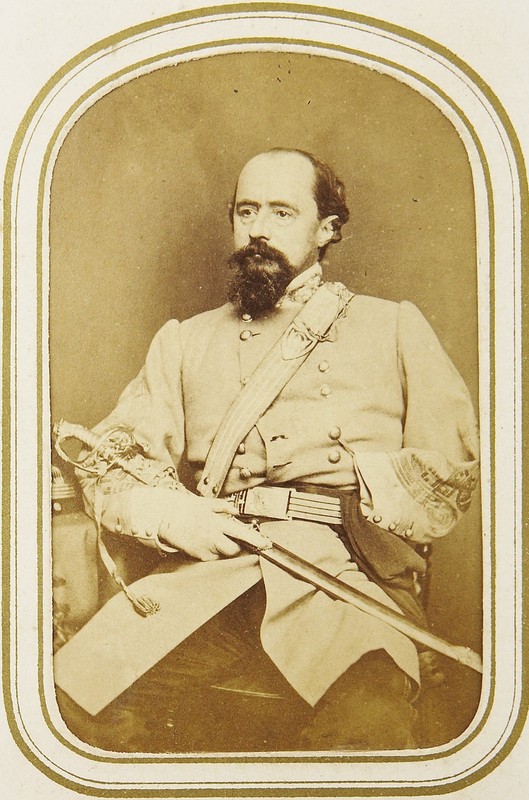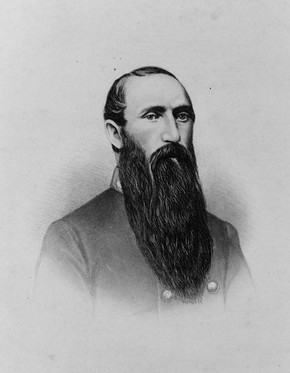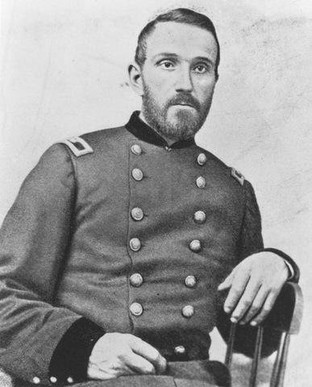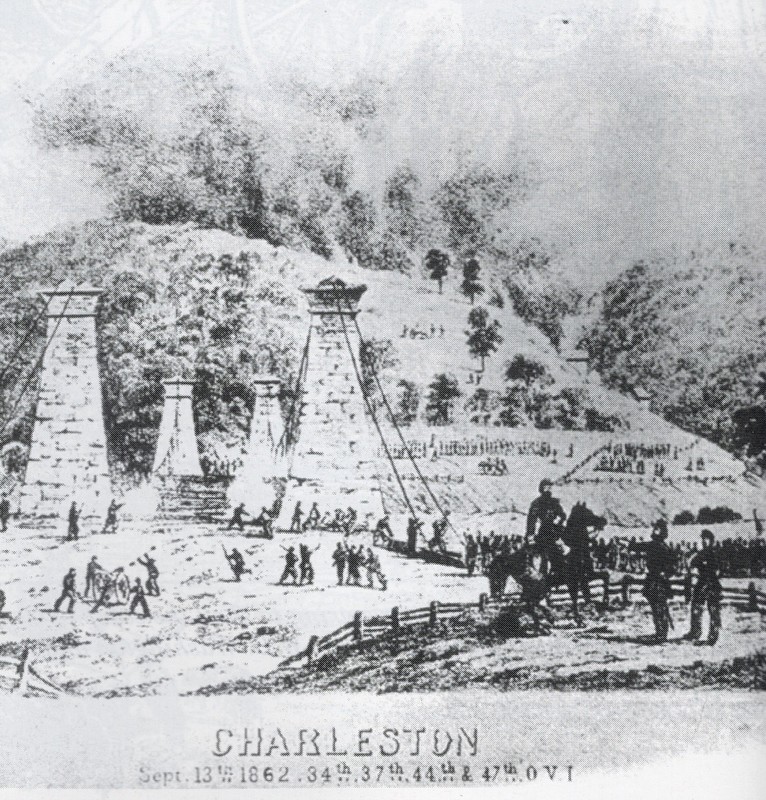[Charleston's Civil War Trails Markers] Lightburn's Retreat
Introduction
Text-to-speech Audio
Images
General William W. Loring, C.S.A. Commander of Confederate forces in the Kanawha Valley in 1862. After the war, he went on to serve in Egypt with about 50 Civil War veterans, working to modernize the Egyptian Army. National Archives.

Colonel Albert G. Jenkins, C.S.A. conducted a daring cavalry raid during the campaign. He later served fought at Gettysburg and, in 1864, died after a wounded arm had to be amputated at the Battle of Cloyd's Mountain in West Virginia.

Colonel Joseph Lightburn, Union commander in the Kanawha Valley, August-September 1862. He later served with General William Tecumseh Sherman in the Western Theater and was wounded during the siege of Atlanta.

Union troops cutting the suspension cables of the Elk River bridge. The destruction of the bridge prevented Confederate forces from pursuing Lightburn's retreating army.

General William W. Loring, C.S.A. Commander of Confederate forces in the Kanawha Valley in 1862. After the war, he went on to serve in Egypt with about 50 Civil War veterans, working to modernize the Egyptian Army. National Archives

Colonel Albert G. Jenkins, C.S.A. conducted a daring cavalry raid during the campaign. He later served fought at Gettysburg and, in 1864, died after a wounded arm had to be amputated at the Battle of Cloyd's Mountain in West Virginia.

Colonel Joseph Lightburn, Union commander in the Kanawha Valley, August-September 1862. He later served with General William Tecumseh Sherman in the Western Theater and was wounded during the siege of Atlanta.

Union troops cutting the suspension cables of the Elk River bridge. The destruction of the bridge prevented Confederate forces from pursuing Lightburn's retreating army.

Backstory and Context
Text-to-speech Audio
Outnumbered two-to-one, and having determined that he could not make a stand against Confederate General William Loring's oncoming troops from his present positions in Charleston, Union Colonel Joseph Lightburn instructed loyal Union citizens to evacuate, then set fire to government buildings and his military stores. Unfortunately, the quartermaster's office had been set up in Asbury Chapel, the burning of which led to a later claim that the cold-hearted Federals had intentionally burned a house of worship. Other unintended buildings were caught up in the blaze, as well, causing considerable damage in what is now downtown Charleston.
Lightburn quickly withdrew his troops across the Elk River, where under heavy fire from the Confederates they cut the cables of the suspension bridge to prevent the enemy from crossing in pursuit. Loring's Confederates searched vainly for a usable ford or enough boats to cross, but discovered nothing and discontentedly settled into Charleston. Thus began Lightburn's 50-mile trek northwest from Charleston to Point Pleasant, on the Ohio River.
The Union commander's work was cut out for him. His 13-mile supply train consisted of 700 wagons laden with provisions and ammunition, and he had only 3,500 men to fight a long rearguard action against 10,000 pursuing Confederates. To complicate matters, the road and Kanawha River were choked with refugees from Charleston, including large numbers of runaway slaves who feared the consequences of recapture. The diary of Victoria Teays, who witnessed the column near the mouth of the Coal River, remarks: "Such a sight I never saw before or expect to see again....the river as far as you could see up and down was full of boats of all kinds...a person could have almost crossed the river by jumping from one boat to another."
Lightburn's luck held. General Loring had meant for the retreating Union forces to be caught between the pincers of his main body and a large cavalry force under Colonel A.G. Jenkins, who had conducted a daring raid through exposed Union territory and was lying in wait westward of Charleston, in Barboursville. But on the night of Sept. 8, 1862, the 2nd West Virginia Cavalry Regiment caught Jenkins by surprise in a night attack on his camp and put him to route. By the time Jenkins reorganized his command and commenced the offensive several days later, the 2nd West Virginia had rejoined the retreating column and Lightburn's available forces kept vigilant guard over their vulnerable wagon train.
The destruction of the bridge over the Elk River hampered effective Confederate pursuit, so it was up to Jenkins to harass Lightburn's withdrawing Yankees. He lacked sufficient numbers for a concerted attack, and was forced to content himself with shadowing their line of retreat--though his presence continued to be a cause of concern for the Federals.
Lightburn managed to conduct the withdrawal with no major setbacks, passing through Sissonville and Ripley before many of his troops embarked upon steamships in Ravenswood and were conveyed to Point Pleasant on the Ohio River. Many of the civilians made their way to nearby Gallipolis. Lightburn consolidated his forces and fortified Point Pleasant, waiting for what he thought was an inevitable Confederate attack. It never came.
Aftermath
Alarmed by a string of dramatic defeats in Virginia and Tennessee, the news of the loss of the Kanawha Valley prompted military leadership in Washington D.C. to send new commanders to Point Pleasant and relieve Lightburn. The former Union commander, General J.D. Cox, soon resumed command of the region and in October 1862 advanced on Charleston. Loring's troops evacuated the city and retreated. They had held Charleston for a mere six weeks.
Perspectives
Lightburn's Retreat has received both criticism and praise in the decades since. Historians and contemporary accounts have commended Colonel Lightburn for successfully withdrawing a large body of troops, supplies and civilians in the face of overwhelming enemy force. Others have cast the retreat as a barely-controlled panic, typified by confusion and a failure to destroy key installations such as the salt works near Charleston (salted meat was an essential military supply at the time, and Lightburn's failure to destroy the salt works allowed the Confederates to extend the life of their rations significantly).
A brief analysis of the episode by General J.D. Cox seems to straddle both sides of the argument. He postulates that Lightburn was precipitous to have fallen back to Charleston from his initial positions in Fayette County, arguing that encampments there were so strong as to have denied Loring access to West Virginia altogether. Cox goes on to defend Lightburn, however, pointing out that administrative mistakes at headquarters in Washington had left the Kanawha region with no overall commander whatsoever. Lightburn, he claims, did his best in a bad situation with no strategic oversight from ranking officers who might have had knowledge of the larger situation.
It is notable that Lightburn appears to have possessed no knowledge of Jenkins' destructive raid through the countryside north and west of him. Colonel Jenkins had cut all the way across West Virginia and into Ohio, then positioned himself neatly upon Lightburn's exposed line of retreat, in an audacious display worthy of Confederate cavalry's well-earned reputation.
Controversy surrounding the Retreat was alive and well into the 1990s, when a Charleston Daily Mail article resurfaced in The West Virginia Hillbilly entitled, "The Sad Saga of Lightburn's Retreat From Kanawha Valley." The article criticized Lightburn's leadership, and Lightburn's descendants responded with a letter in 1994 to the Director of West Virginia Archives and History, citing contemporary accounts and letters to refute the article's claims. A collection of these items resides at the West Virginia and Regional History Center in Morgantown.
Sources
A&M 3670, Joseph Andrew Jackson Lightburn, Civil War General, Articles and Letters Regarding Joseph Lightburn, West Virginia and Regional History Center, West Virginia University Libraries.
Battle of Charleston, Historical Marker Project. September 18th 2014. Accessed January 20th 2021. https://historicalmarkerproject.com/markers/HM145Y_battle-of-charleston_Charleston-WV.html.
Barton, Thomas H.. Autobioraphy of Dr. Thomas H. Barton.... Charleston, West Virginia. West Virginia printing Company, 1890. 82-87. Digitized by the New York Public Library, 2007.
Cox, Jacob Dolson. April 1861-November 1863: Military Reminiscences of the Civil War. Vol. 1. C. Scribner's sons, 1900. 396-399. Digitized by University of California, 2010.
Emmick, David. Amick Partisan Rangers. Edition 2nd. Flying A Books, 2017. 252-53
Johnson, Flora Smith. The Civil War Record of Albert Gallatin Jenkins, C. S. A.. WVCulture.org. Accessed September 19, 2017. http://www.wvculture.org/history/journal_wvh/wvh8-1.html. West Virginia Archives & History
Peyton, Billy Joe. Battle of Charleston. West Virginia Encyclopedia. January 08, 2015. Accessed September 19, 2017. https://www.wvencyclopedia.org/articles/2425.
Rizer, Chris. "Mason County Memories: Lightburn’s Retreat." Point Pleasant Register(Point Pleasant), September 15, 2017. http://www.mydailyregister.com/news/18446/mason-county-memories-lightburns-retreat
